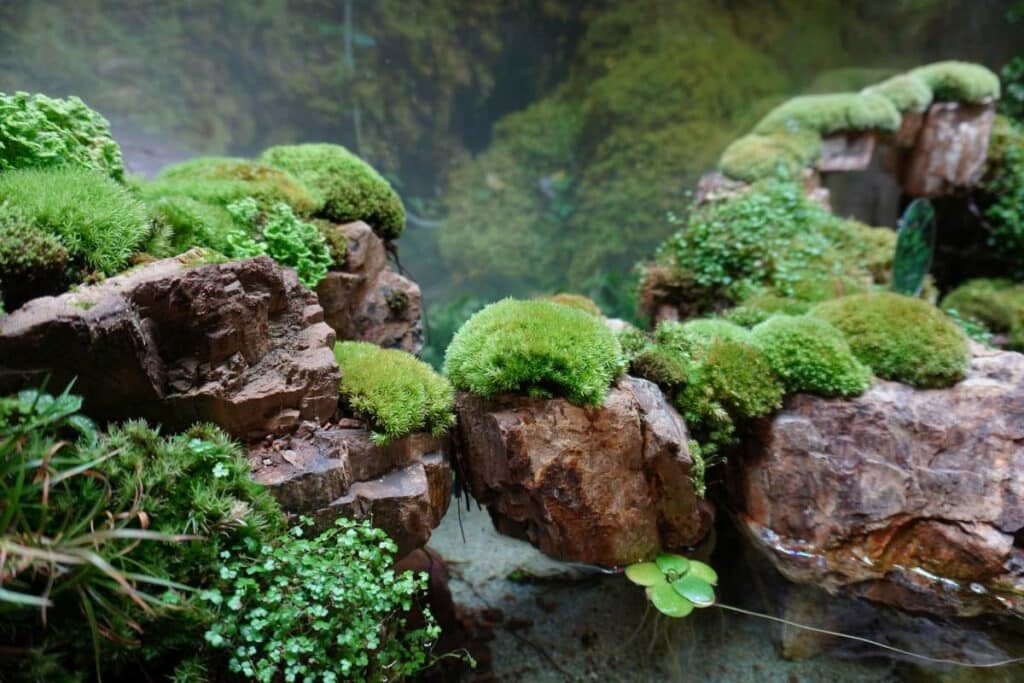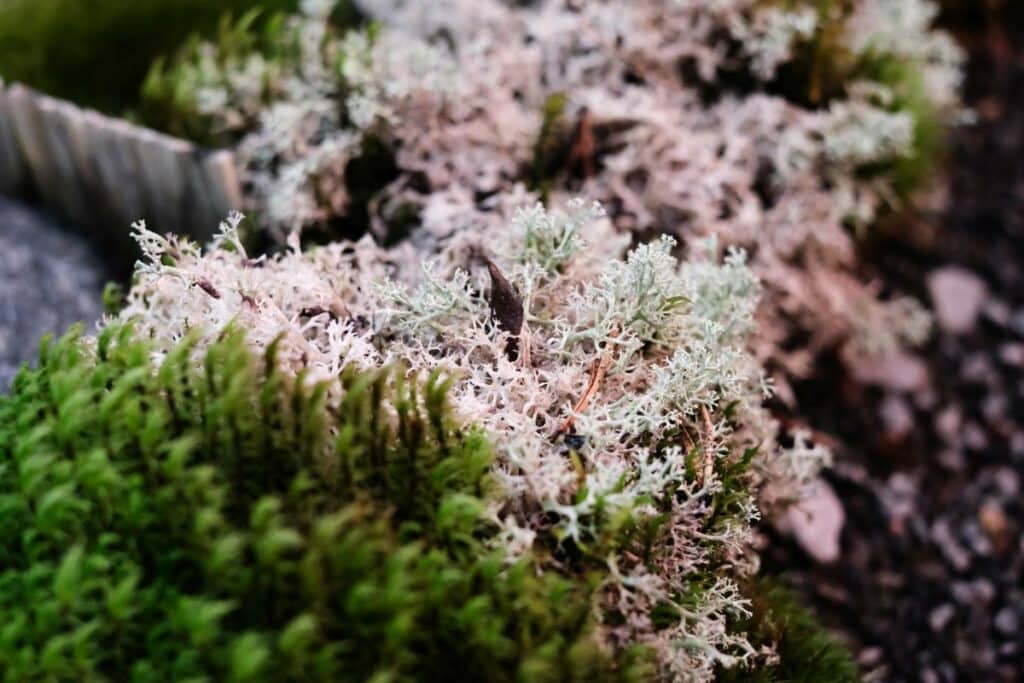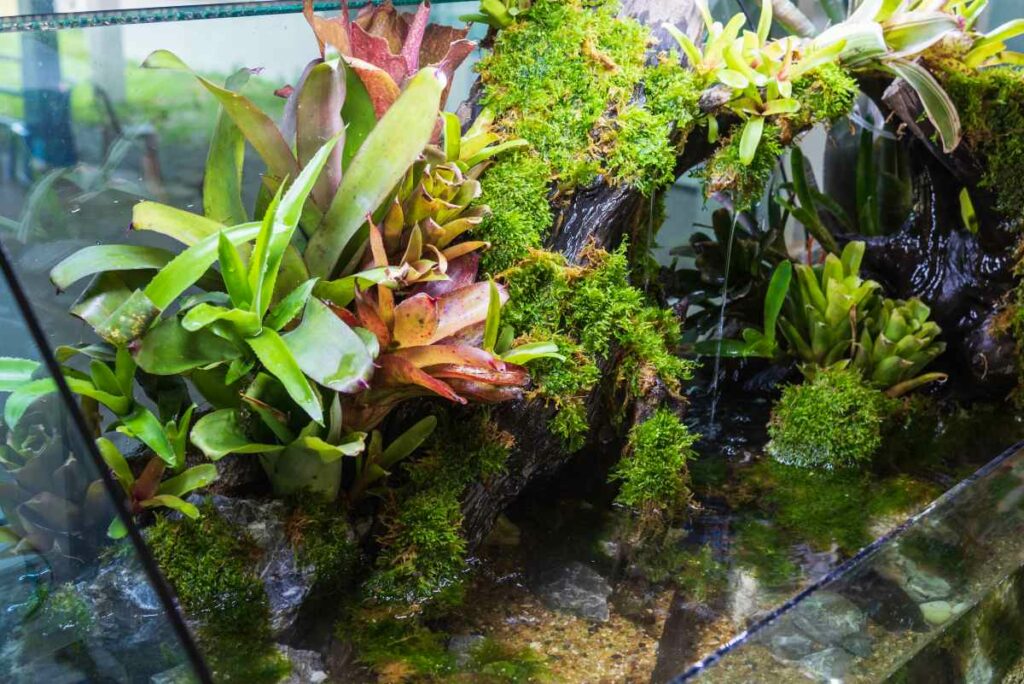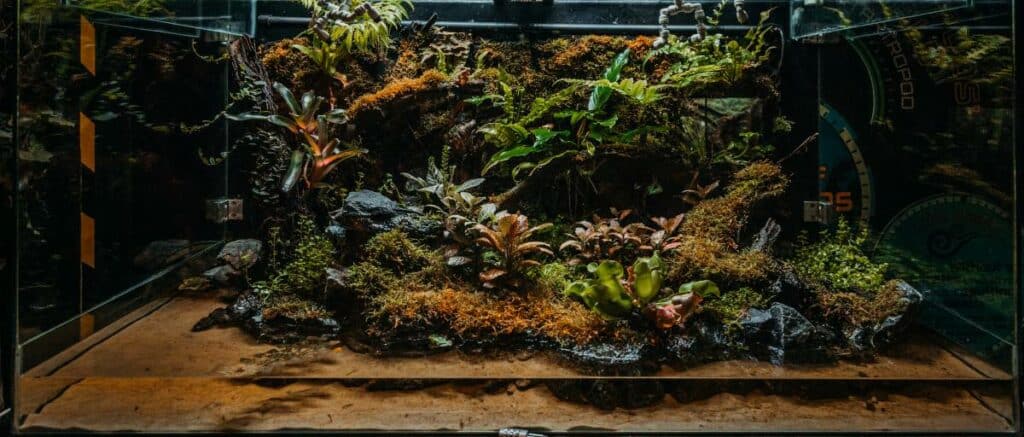the essentials in brief
Paludarium residents who feel comfortable in water and land and do not have high demands, such as bullfrogs, axolotls, turtles or water dragons, are suitable for beginners. Read more here...
A paludarium is built by designing, filtering, heating, lighting and planting a tank with a land and a water area. Read more here...
The water for a paludarium is treated by treating it with a water conditioner, adapting it to the needs of the animals and regularly replacing some of it. Read more here...
A paludarium is a fascinating way to combine two different habitats in one: water and land. A paludarium can be used to keep fish, amphibians, reptiles or crabs that thrive in warm, humid swampy areas. But how do you set up a paludarium and what do you have to consider? In this blog post you will find out everything you need to know about the paludarium.
What do you need for a paludarium?

Before you can start setting up your paludarium, there are a few basic things you need to get hold of. This includes
Tip: Carefully choose the inhabitants of your paludarium so that they feel comfortable and get along with each other both in the water and on land. For example, different types of frogs and newts, pond turtles, vampire crabs or green water dragons are suitable.
- The basin: The pelvis is the heart of the paludarium. It should be made of glass or acrylic and be the right size for the intended occupants. Make sure the pool is stable, tight, and has no sharp edges. You can buy a ready-made paludarium or modify an aquarium or terrarium accordingly.
- Lighting: Lighting is important for plant growth and animal welfare. You should use special paludarium lighting suitable for both the water and land parts. The lighting should simulate daylight in order to create a natural day-night rhythm. The lights should be on for about 10 to 12 hours a day.
- Heating: The heater ensures a comfortable temperature in the paludarium. A heater that heats both the water and the air should be used. The heater should be equipped with a thermostat that keeps the temperature constant. The optimal temperature depends on the needs of the animals, but is usually between 22 and 28 degrees Celsius.
- filtering: Filtering is necessary to keep the water in the paludarium clean and clear. A filter that works both mechanically and biologically should be used. The filter must be cleaned and maintained regularly. The filter should be placed in such a way that it does not disturb or attract attention, but is still easily accessible.
- The decoration: The decoration gives the paludarium its individual character. You can use different materials to design the water and land part, e.g. B. stones, roots, cork, clay or plastic. Make sure that the decoration has no sharp edges and does not emit any pollutants. In addition, the decoration should be stable and not slip or tip over.
Tip: If you are unsure which materials you can use for your paludarium, it is best to seek advice from a specialist shop.
How do I set up a paludarium?

After you have obtained all the necessary utensils, you can start setting up your paludarium. To do this, you should follow the steps below:
- Thoroughly clean the pool with clear water and a soft cloth. Do not use soap or other cleaning products as they can leave residues that are harmful to the animals.
- Lay a drainage layer on the bottom of the tank. This consists of coarse material such as expanded clay or gravel and prevents the formation of waterlogging. The drainage layer should be about 5 cm high.
- Cover the drainage layer with fleece or netting. This prevents the overlying layer of soil from sinking into the drainage layer and clouding the water.
- Fill in the land part with a suitable layer of soil. This consists of a nutrient-rich substrate such as peat, coconut fiber or special terrarium soil. The layer of soil should be about 10 cm high.
- Design the transition area between the water and land parts. This consists of a sloping escarpment or step separating the water from the land. The transition area can be fixed with stones or roots and planted.
- Fill the water part with a suitable layer of water. This consists of clean tap water or distilled water that has been treated with a water conditioner. The water layer should be about 20 cm high.
- Design the water area with a suitable layer of soil. This consists of fine material such as sand or gravel and provides support for the plant roots. The soil layer should be about 5 cm high.
Note: Make sure there is a clean boundary between the land and water parts so that the water is not contaminated by soil material or the soil becomes too wet. For example, you can use rocks, roots, or styrofoam to create a barrier.
- Plant the paludarium with suitable plants for the water and land part. Choose plants that are adapted to the conditions in the paludarium and that suit your animals. Make sure the plants have enough light, nutrients and space. Prune plants regularly to prevent overgrowth.
- Set up the technical facilities such as lighting, heating and filters. Hide cables and hoses behind decorations or in the layer of soil as much as possible. Turn on the devices and check if everything works.
- Allow the paludarium to break in for a few weeks before adding animals. During this time, the plants can take root, stabilize the water and create a biological balance. Measure the water values such as pH value, nitrite, nitrate and carbonate hardness regularly and correct them if necessary.
- Carefully place the animals in the paludarium. Gradually acclimate them to the new conditions by first letting them swim in a separate container with the paludarium water. Monitor the animals closely for signs of stress or illness.
How do I care for a paludarium?

A paludarium is not a sure-fire success, but requires regular care. You should note the following points:
- Feed your animals species-appropriate and varied. Avoid overfeeding, as this can pollute the water and lead to obesity or deficiency symptoms.
- Clean the paludarium weekly of algae, dirt and dead plant parts. Vacuum the substrate in the water part and change about 20% of the water. Clean or change the filter according to the manufacturer's instructions.
- Daily inspection of the paludarium for damage and leaks. Also check the technical equipment for its functionality. Repair or replace defective parts promptly.
- Take care of your animals and observe their behavior. This way you can recognize early on if something is wrong or if they are bored.
What problems can occur with your paludarium?
As with any hobby, problems can arise with your paludarium that can spoil your enjoyment. The most common problems are:
Algae growth
Algae, while natural and not harmful per se, can affect the appearance of your paludarium and compete with plants. To avoid or reduce algae growth, you should take the following measures:
- Reduce lighting duration or intensity.
- Avoid direct sunlight on the pool.
- Feed sparingly and remove leftover food.
- Change some of the water regularly.
- Use algae eaters like shrimp or snails.
Diseases
Diseases can occur in both plants and animals and have various causes. To prevent or treat diseases, you should take the following measures:
- Keep the water values and the temperature in the optimal range.
- Feed your animals a balanced and vitamin-rich diet.
- Quarantine new animals or plants before introducing them into the paludarium.
- Recognize symptoms of illness early and isolate sick animals or plants.
- Use appropriate medication or home remedies after consulting a professional.
aggression
Animals can show aggression when they feel threatened, stressed, or bored. To avoid or reduce aggression, you should take the following measures:
- Choose animals that are compatible with each other and have similar needs.
- Offer your animals enough space and retreat options.
- Avoid overstocking or understocking in the paludarium.
- Offer your animals variety with toys, treats or new decorations.
Paludariums – discover a fascinating world on a small scale
Paludariums are a special form of aquaristics that make it possible to combine different habitats such as water, land and air in one tank. You can tend a variety of plants and animals that are otherwise difficult to observe. In addition to being aesthetically pleasing, paludariums are educational and relaxing. But they also require careful planning, design and care to create a harmonious and healthy ecosystem. If you are interested in paludariums, you should inform yourself well before you venture into this exciting hobby. We hope to have given you some useful tips and suggestions with this blog post.



